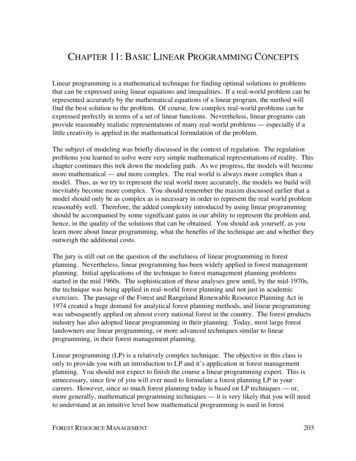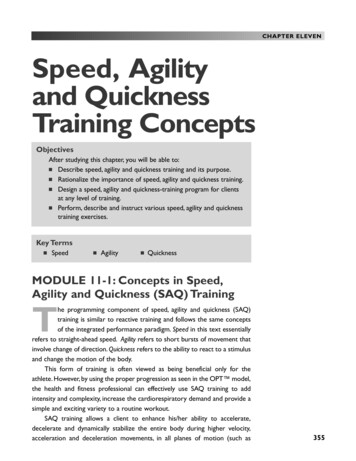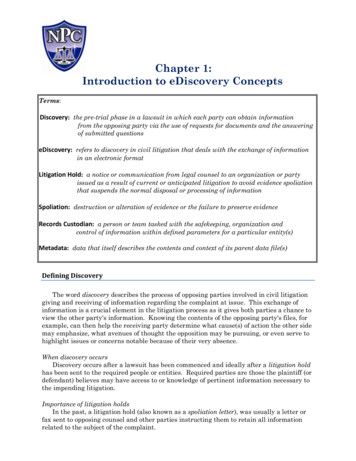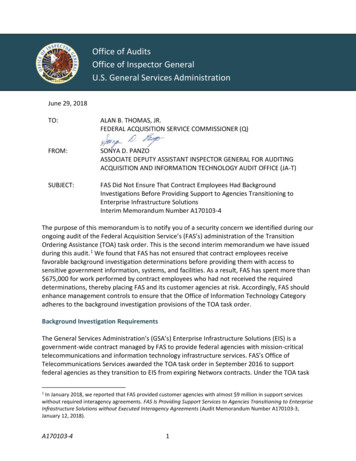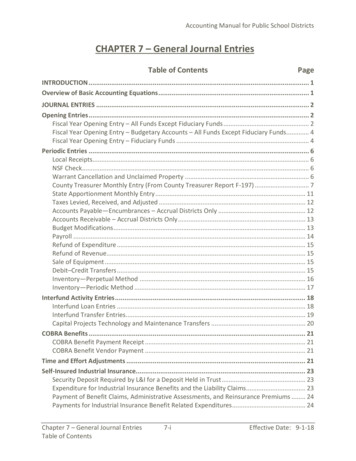
Transcription
Chapter 10GENERAL CONCEPTS OF MEASUREMENTAND SCALINGQuestions focus on the problem we are trying to solve, while answers are more closely associated with themeasurement scale we are using to achieve our analysis.Survey research, as a source of marketing information addresses many topics ofpractical interest, including concept testing for new products, corporate image measurement, adcopy evaluation, purchase intentions, customer satisfaction, and so forth. Regardless of theresearch topic, useful data is obtained only when the researcher exercises care in makingprocedural decisions such as:1.2.3.4.Defining what is to be measuredDeciding how to make the measurementsDeciding how to conduct the measuring operationsDeciding how to analyze the resulting dataDefinitions and decisions play a significant role in scientific inquiry, especially inmarketing research and the behavioral sciences.In the first section of this chapter, we focus on conceptual and operational definitions andtheir use in research. Increasingly, behavioral scientists are paying greater attention to definingthe concepts measured in their specific disciplines, and refining operational definitions thatspecify how to measure and quantify the variables defining the concepts.In the next section we discuss measurement scales and their relationship to theinterpretation of statistical techniques. This section serves as useful background for thediscussion of statistical techniques covered in later chapters. We then discuss the pragmatics ofwriting good questions.The overall quality of a research project depends not only on the appropriateness andadequacy of its research design and sampling techniques, but also on the measurementprocedures used. The third section of this chapter looks at measurement error and how we maycontrol the reliability and validity in these measurements.Definitions in Marketing MeasurementMarketers measure marketing program success as increased brand awareness, adawareness, ratings of brand likeability and uniqueness, new product concept ratings and purchaseintent, and customer satisfaction (Morgan, 2003). Researchers will often model these constructs.Models are representations of reality and therefore raise the fundamental question of howwell each model confidently represents reality on all significant issues. The quality of a model isjudged against the criteria of validity and utility. Validity refers to a model’s accuracy indescribing and predicting reality, whereas utility refers to the value it adds to the making ofdecisions. A sales forecasting model that does not forecast sales with reasonable accuracy isprobably worse than no sales forecasting model at all.Model quality also depends on completeness and validity, two drivers of model accuracy.Managers should not expect a model to make decisions for them, but instead models should be219Scott M. Smith and Gerald S. Albaum, An Introduction to Marketing Research, 2010
viewed as one additional piece of information to help make decisions.Clearly, managers will probably benefit from models that are simple enough tounderstand and deal with. But models used to help make multi-million-dollar decisions should bemore complete than those used to make hundred-dollar decisions. The required sophistication ofa model to be used depends on the model’s purpose. We measure the value of a model based onits efficiency in helping us arrive at a decision. Models should be used only if they can help usarrive at results faster, with less expense, or with more validity.Building Blocks for Measurement and ModelsWe cannot measure an attitude, a market share, or even sales, without first specifyinghow it is defined, formed, and related to other marketing variables. To better understand this, wemust briefly study the building blocks of measurement theory: concepts, constructs, variables,operational definitions, and propositions.Concepts and ConstructsA concept is a theoretical abstraction formed by a generalization about particulars.“Mass”, “strength”, and “love” are all concepts, as are “advertising effectiveness”, “consumerattitude”, and “price elasticity”. Constructs are also concepts, but they are observable,measurable, and are defined in terms of other constructs. For example, the construct “attitude”may be defined as “a learned tendency to respond in a consistent manner with respect to a givenobject of orientation.”VariablesResearchers loosely call the constructs that they study variables. Variables are constructsin measured and quantified form. A variable can take on different values (i.e., it can vary).Operational DefinitionsWe can talk about “consumer attitudes” as if we know what it means, but the term makeslittle sense until we define it in a specific, measurable way. An operational definition assignsmeaning to a variable by specifying what is to be measured and how it is to be measured. It is aset of instructions defining how we are going to treat a variable. For example, the variable“height” could be operationally defined in a number of different ways, including measures ininches with a precision ruler with the person (1) wearing shoes, or (2) not wearing shoes, (3) byan altimeter or barometer, or (4) for a horse, by the number of “hands”As another example, measuring “purchase intentions” for Brand X window cleaner mightbe operationally defined as the answer to the following question:The researcher could have just as appropriately defined a measurement of “purchaseintention” in other ways. For example, the concepts of “attitude” and “importance”, which havebeen summed as the multiplicative product of a series of attributes like cleaning ability, freshsmell, etc. This would appear as:220Scott M. Smith and Gerald S. Albaum, An Introduction to Marketing Research, 2010
PPurchaseBehaviorTowardBI PurchaseIntentionFor Brand XAi Attitudesabout Brand X WindowCleaner AttributesBiImportance ofAttributes ofBrand X Window CleanerPropositionsA proposition defines the relationships between variables, and specifies both thevariables influencing the relationship and the form of the relationship. It is not enough to simplystate that the concept “sales” is a function of the concept “advertising”, such that S f (Adv).Intervening variables must be specified, along with the relevant ranges for the effect, includingwhere we would observe saturation effects, threshold effects, and the symbolic form of therelationship.Integration into a Systematic ModelA proposition is quite similar to a model. A model is produced by linking propositionstogether to provide a meaningful explanation for a system or a process. When concepts,constructs, variables and propositions are integrated into a model for a research plan, we shouldconceptually ask the following questions:Are concepts and propositions specified?Are the concepts relevant to solving the problem at hand?Are the principal parts of the concept clearly defined?Is there consensus as to which concepts are relevant in explaining the problem?Are the concepts properly defined and labeled?Is the concept specific enough to be operationally reliable and valid?Do clear assumptions made in the model link the concepts?Are the limitations of the model stated?Can the model explain and predict?Can the model provide results for managerial decision making?Can the model be readily quantified?Are the outcomes of the model supported by common sense?If the model does not meet the relevant criteria, it probably should be revised. Conceptdefinitions may be made more precise; variables may be redefined, added, or deleted; operationaldefinitions and measurements may be tested for validity; and/or mathematical forms revised.INACCURACIES IN MEASUREMENTBefore delving into measurement scales and question types, it is helpful to remember thatmeasurements in marketing research are rarely “exact.” Inaccuracies in measurement arise froma variety of sources or factors. A portion of this variation among individual scores may representtrue differences in what is being measured, while other variation may be error in measurement.For any given research project, not all will necessarily be operative, but the many possiblesources causing variations in respondent scores can be categorized as follows:True differences in the characteristic or propertyOther relatively stable characteristics of individuals which affect scores (intelligence, extent of education,information processed)Transient personal factors (health, fatigue, motivation, emotional strain)Situational factors (rapport established, distractions that arise)221Scott M. Smith and Gerald S. Albaum, An Introduction to Marketing Research, 2010
Variations in administration of measuring instrument, such as interviewersSampling of items included in the instrumentLack of clarity (ambiguity, complexity, interpretation of words and context)Mechanical factors (lack of space to record response, appearance of instrument)Factors in the analysis (scoring, tabulation, statistical compilation)Variations not otherwise accounted for (chance), such as guessing an answerIn the ideal situation, variation within a set of measurements would represent only truedifferences in the characteristic being measured. For instance, a company wanting to measureattitudes toward a possible new brand name and trademark would like to feel confident thatmeasurement differences concerning the proposed names represent only the individuals’differences in this attitude. Obviously the ideal situation for conducting research seldom, if everexists. Measurements are often affected by characteristics of individual respondents such asintelligence, education level, and personality attributes. Therefore, the results of a study willreflect not only differences among individuals in the characteristic of interest but also differencesin other characteristics of the individuals. Unfortunately, this type of situation cannot be easilycontrolled unless the investigator knows all relevant characteristics of the population memberssuch that control can be introduced through the sampling process.There are many influences in a measurement other than the true characteristic ofconcern—that is, there are many sources of potential error in measurement. Measurement errorhas a constant (systematic) dimension and a random (variable) dimension. If the error is trulyrandom, (it is just as likely to be greater than the true values as less) then the expected value ofthe sum of all errors for any single variable will be zero, and therefore less worrisome thannonrandom measurement error (Davis, 1997). Systematic error is present because of a flaw in themeasurement instrument or the research or sampling design. Unless the flaw is corrected, there isnothing the researcher can do to get valid results after the data are collected. These two subtypesof measurement error affect the validity and reliability of measurement, topics that are discussedin the later part of this chapter. But now that we are aware of the conceptual building blocks anderrors in measurement that should be considered in developing measurement scales, we willconsider the types of measurement and associated questions that are commonly used inmarketing research today.MEASUREMENT CONCEPTSMeasurement can be defined as a way of assigning symbols to represent the properties ofpersons, objects, events, or states. These symbols should have the same relevant relationship toeach other as do the things they represent. Another way of looking at this is that measurement is“the assignment of numbers to objects to represent amounts or degrees of a property possessedby all of the objects” (Torgerson, 1958, p. 19). If a characteristic, property, or behavior is to berepresented by numbers, a one-to-one correspondence between the number system used and thevarious quantities (degrees) of that being measured must exist. There are three importantcharacteristics or features of the real number series:1.2.3.Order. Numbers are ordered.Distance. Differences exist between the ordered numbers.Origin. The series has a unique origin indicated by the number zero.A scale of measurement allows the investigator to make comparisons of amounts and changes inthe variable being measured. It is important to remember that it is the attributes or characteristicsof objects we measure, not the objects themselves.222Scott M. Smith and Gerald S. Albaum, An Introduction to Marketing Research, 2010
Primary Types of ScalesTo many people, the term scale suggests such devices as a bathroom scale, pan balances,yard sticks, gasoline gauges, measuring cups, and similar instruments for finding length, weight,volume, and the like. We ordinarily tend to think about measurement in the sense of well-definedscales possessing a natural zero and constant unit of measurement. In the behavioral sciences(including marketing research), however, we must frequently settle for less-precise data. Scalescan be classified into four major categories, designated as Nominal, Ordinal, Interval, andRatio scales.Each scale possesses its own set of underlying assumptions about order, distance andorigin, and how well the numbers correspond with real-world entities. As our rigor inconceptualizing concepts increases, we can upgrade our measurement scale. One example is themeasurement of color. We may simply categorize colors (nominal scale), or measure thefrequency of light waves (ratio scale).The specification of scale is extremely important in all research, because the type of measurementscale dictates the specific analytical (statistical) techniques that are most appropriate to use inanalyzing the obtained data.Nominal ScalesNominal scales are the least restrictive and, thus, the simplest of scales. They supportonly the most basic analyses. The nominal scale serves only as labels or tags to identify objects,properties or events. The nominal scale does not possess order, distance, or origin. For example,we can assign numbers to baseball p
GENERAL CONCEPTS OF MEASUREMENT AND SCALING Questions focus on the problem we are trying to solve, while answers are more closely associated with the measurement scale we are using to achieve our analysis. S urvey research, as a source of marketing information addresses many topics of practical interest, including concept testing for new products, corporate image measurement, ad copy .
